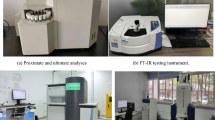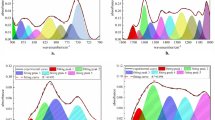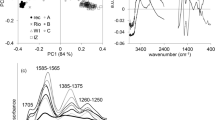Abstract
X-RAY and other physical and chemical evidence indicates that coals assume a graphitic structure with metamorphism. X-ray diffraction patterns of some meta-anthracites show (hkl) reflexions that arise from the three-dimensional unit cell of a graphite lattice1,2. For the anthracites, a number of diffraction bands can be detected which coincide with the (hk) reflexions of aromatic layers (having a two-dimensional unit cell of side approximately equal to that of graphite layers)3; the remainder of the bands can be attributed to the (00l) reflexions of these layers packed ‘turbostratically’4. Medium- and low-rank coals also give diffuse diffraction patterns that can be indexed as the (hk) and (00l) reflexions of aromatic layers. These observations led to the development of methods for quantitative analysis of X-ray intensity profiles of coals, permitting estimation of bond-lengths, fraction of carbon in aromatic layers (the remainder assumed to be roentgenamorphous), and size distribution and stacking of the layers3,5,6.
This is a preview of subscription content, access via your institution
Access options
Subscribe to this journal
Receive 51 print issues and online access
$199.00 per year
only $3.90 per issue
Buy this article
- Purchase on Springer Link
- Instant access to full article PDF
Prices may be subject to local taxes which are calculated during checkout
Similar content being viewed by others
References
Quinn, A. W., and Glass, H. D., Econ. Geol., 53, 563 (1958).
Ergun, S., O'Donnell, H. J., and Mentser, M., “A Study of Meta-anthracites” (unpublished).
Hirsch, P. B., Proc. Roy. Soc., A, 226, 364 (1954).
Biscoe, J., and Warren, B. E., J. App. Phys., 13, 364 (1942).
Diamond, R., Acta Cryst., 10, 359 (1957).
Diamond, R., Acta Cryst., 11, 129 (1958).
Cartz, L., Diamond, R., and Hirsch, P. B., Nature, 177, 500 (1956).
Ergun, S., Donaldson, W. F., and Breger, I. A., “Some Physical and Chemical Properties of Vitrains associated with Uranium”, presented at the Third Internat. Conf. on Coal Science, Valkenburg (1959).
Reggel, L., Raymond, R., and Wender, I., “Reduction of Coal by Lithium–ethylenediamine”, preprints—Division of Gas and Fuel Chemistry, 135th Meeting of the Amer. Chem. Soc., Boston, Mass., April 1959.
Ergun, S., and Wender, I., “X-ray Scattering Intensities of Coals reduced with Lithium in Ethylenediamine”, presented at the Third Internat. Conf. on Coal Science, Valkenburg (1959).
Reggel, L., Friedel, R. A., and Wender, I., J. Org. Chem., 22, 89 (1957).
Debye, P., Ann. Physik, 46, 809 (1915).
Patterson, A. L., Phys. Rev., 46, 372 (1934).
Tiensuu, V. H., Ergun, S., Donaldson, W. F., and Smith, jun., R. W. (unpublished work).
Author information
Authors and Affiliations
Rights and permissions
About this article
Cite this article
ERGUN, S., TIENSUU, V. Alicyclic Structures in Coals. Nature 183, 1668–1670 (1959). https://doi.org/10.1038/1831668a0
Issue Date:
DOI: https://doi.org/10.1038/1831668a0
This article is cited by
Comments
By submitting a comment you agree to abide by our Terms and Community Guidelines. If you find something abusive or that does not comply with our terms or guidelines please flag it as inappropriate.



